 would be written as
would be written as secretNumber ← 7or
 .
.
 would be written as
would be written as
DISPLAY("Why did the chicken cross the road?")
userResponse ← INPUT() .
.
INPUT()accepts the value from the user and returns that input value, which is then assigned to the variable
userResponsewith the
←syntax. In Snap!, this is just like how
answer accepts a value from the user and reports it, and that report is what the computer sets the variable user response to.score ← score + 1or
 .
.
 would be written as
would be written as costumes[2]or
![costumes[2] costumes[2]](/bjc-r/img/2-complexity/accessing-blocktran.png) . All three versions of this code would report/return the penguin costume (if only the AP language had costumes as a data type):
. All three versions of this code would report/return the penguin costume (if only the AP language had costumes as a data type):
 would be written as
would be written as [Señora, Ms. C, my cat, Hannah, Jake]. The items are positioned in the list in the order they appear in the text: "Señora" has index 1, "Ms. C" has index 2, and so on.
 would be written as
would be written as shoppingList ← []or
![shoppingList ← [] shoppingList ← []](/bjc-r/img/2-complexity/shoppinglist-empty-list-assignment-blocktran.png) .
. would be written as
would be written as shoppingList ← [apples, bread, carrots, rice, pasta]or
![shoppingList ← [apples, bread, carrots, rice, pasta] shoppingList ← [apples, bread, carrots, rice, pasta]](/bjc-r/img/2-complexity/shoppinglist-full-list-assignment-blocktran.png) . (In this app, you'll want the
. (In this app, you'll want the shopping list to begin empty, and then the user will add or insert additional grocery items one at a time.) would be written as
would be written as INSERT(shoppingList, 2, "tomatoes")or
 .
. would be written as
would be written as APPEND(shoppingList, "tomatoes")or
 .
. would be written as
would be written as REMOVE(shoppingList, 2)or
 .
.
item of anywhere you can use any other expression. For example:
 would be written as
would be written as myFavoriteFood ← shoppingList[3]or
![myFavoriteFood ← shoppingList[3] myFavoriteFood ← shoppingList[3]](/bjc-r/img/2-complexity/assigning-element-to-variable-blocktran.png)
 would be written as
would be written as shoppingList[2] ← yourFavoriteFoodor
![shoppingList[2] ← yourFavoriteFood shoppingList[2] ← yourFavoriteFood](/bjc-r/img/2-complexity/assigning-variable-to-element-blocktran.png) .
.
 would be written as
would be written as shoppingList[1] ← shoppingList[3]or
![shoppingList[1] ← shoppingList[3] shoppingList[1] ← shoppingList[3]](/bjc-r/img/2-complexity/assigning-element-to-element-blocktran.png) .
.
When you run this script in Snap!, the second line of code assigns to shopping list 2 the value of shopping list (that is, the same list, not a copy). So, the third line of code modifies both variables:

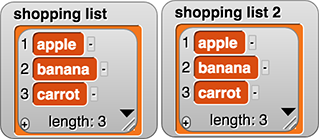
shoppingList2 ← shoppingListmakes a copy of the list. So modifying one of them does not modify the other.
The rules for how to use lists and how they behave differ depending on the programming language you are using.
goto()isn't built in to the AP's language so it is written in lower case like other programmer-defined procedures.
 would be written as
would be written as
FOR EACH point IN myDrawing
{
goto(point)
} .
.
=, >, <, ≥, ≤as well as a sixth:
≠, which means "not-equal" and reports
false if the two inputs are equal and otherwise reports true (if they are not equal). When you write the  block, it will work like this:
block, it will work like this:

These six relational operators all report a Boolean value (true or false).
 ,
,  , and
, and  blocks will appear as
blocks will appear as AND,
OR, and
NOTand will work exactly the same way as they do in Snap!.
mod operator: The expression  would be written as
would be written as 17 MOD 5on the exam. If you see an expression with variables as input to
mod, such as a MOD b, you can assume that a is zero or positive, and b is strictly positive (because you can't divide by 0).
+,
-,
*,
/(plus, minus, times, divide) as well as
MOD. Arithmetic operators are part of most programming languages. (Most text languages use
*rather than
×for multiplication because
×isn't on most keyboards, and because it looks too much like the letter x.)
.png) you can see that the
you can see that the + block is an input to the × block, so the expression means 3×(5+4). Similarly, +4.png) means (3×5)+4. In Snap!, it's as if there are parentheses around every operation. But in text languages, you can write
means (3×5)+4. In Snap!, it's as if there are parentheses around every operation. But in text languages, you can write 3 * 4 + 5without parentheses, so they need the rules you learn in math class (multiplication before addition, and so on). The
mod operator is like multiplication and division; it happens before addition and subtraction. So for example, 7 + 5 MOD 2 - 6means
7 + 1 - 6, which is, of course, 2.
move()and
turn_clockwise()aren't built in to the AP's language so they are written in lower case like other programmer-defined procedures.
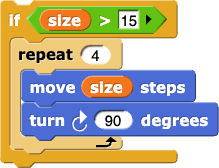 would be written as
would be written as
IF(size > 15)
{
REPEAT 4 TIMES
{
move(size)
turn_clockwise(90)
}
}
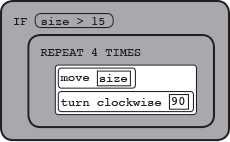
As in Snap!, if the condition (size) > 15 is true, the code inside the if statement runs; if the condition is false, the code does not run.
RETURN(like
report). For example, this definitionIn many languages (including Snap!) variables must be declared in some way (in Snap!, you can click the "Make a variable" button or use the script variables block). But the AP's language doesn't include variable declarations, so you won't see them on the exam.
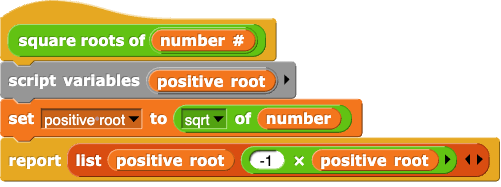
PROCEDURE squareRoots(number)
{
positiveRoot ← sqrt(number)
RETURN([positiveRoot, -1 * positiveRoot])
}
report in Snap!, when a RETURNstatement is executed, the flow of control returns to the place in your code where the procedure was called, and the procedure returns the value of the expression inside the
RETURNcommand or
report block.sqrtisn't built in to the AP's language so it is written in lower case like other programmer-defined procedures.
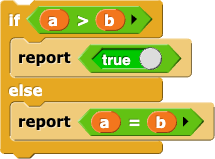 would be written as
would be written as IF(a > b)
{
RETURN(true)
}
ELSE
{
RETURN(a = b)
}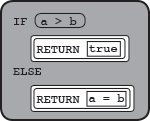
a > bis true, the code in first block of statements runs; if it is false, the code in second block of statements runs.